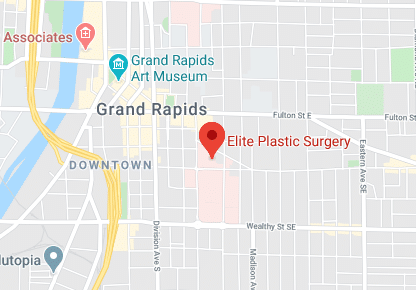 Gravity continually pulls your skin and its underlying support structures downward. Throw in sun damage (particularly in a place where we spend so much time on the nearby lakes and rivers like Grand Rapids) along with the stresses of daily life, and your face takes a beating. As you age, your cheeks lose volume and sag, deep creases form under your eyes and between your nose and mouth, you develop jowls, and loose skin and fat hang under your chin and jaw.
Gravity continually pulls your skin and its underlying support structures downward. Throw in sun damage (particularly in a place where we spend so much time on the nearby lakes and rivers like Grand Rapids) along with the stresses of daily life, and your face takes a beating. As you age, your cheeks lose volume and sag, deep creases form under your eyes and between your nose and mouth, you develop jowls, and loose skin and fat hang under your chin and jaw.
But a facelift with Dr. Armstrong, Dr. Cullen, or Dr. Martin can turn back the clock on facial aging.
Not a new thing
After rhinoplasty (nose surgery), the facelift is generally thought to be the second cosmetic procedure ever performed. Most sources place the first facelift back to 1901 in Poland. Eugen Hollander performed a surgery in response to a request from one of his patients to “lift her cheeks and corners of the mouth.” The facelift was born, and it has been popular ever since. The reason? A natural looking facelift can take from 10-15 years off the facial age of a person. And who wouldn’t like that?!
Areas that facelifts address
Clinically known as a rhytidectomy (of Greek origin meaning wrinkle + excision), a facelift rejuvenates the mid-to-lower face and neck. These are the target areas of the procedure.
Mid-face sagging
Deep creases under the eyes
Nasolabial folds (laugh lines)
Sagging cheeks
Jowls
Loose skin and fat under the chin and jaw
Areas that a facelift won’t fix
Some people have the misperception that a facelift will somehow stop the aging process. Obviously, this isn’t possible, but a facelift turns the clock back a decade or more.
Also, facelifts are targeted to the mid- and lower face. They do not rejuvenate the brows, eyelids, or nose. To address these areas, some patients combine a facelift with a brow lift or eyelid surgery.
Injectable fillers and skin resurfacing procedures can further enhance the effects of a facelift.
Techniques
Techniques have continued to expand. The different facelifts performed by the Elite Plastic Surgery team are categorized by the type of incision, number of tissue layers treated, the areas of the face targeted, and the degree of invasiveness. When you come in for a consultation at Elite, we will discuss all of the options that we feel would best suit your particular situation.
Interested in taking a decade or more off your facial age? Contact us at Elite Plastic Surgery, (866) 331-0612, and set up a consultation for a facelift.


No comments yet.